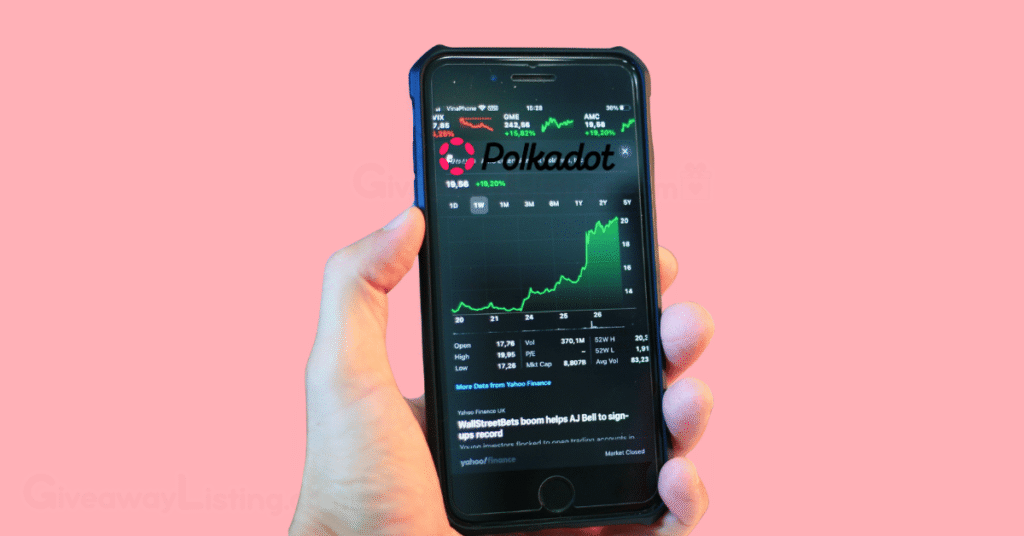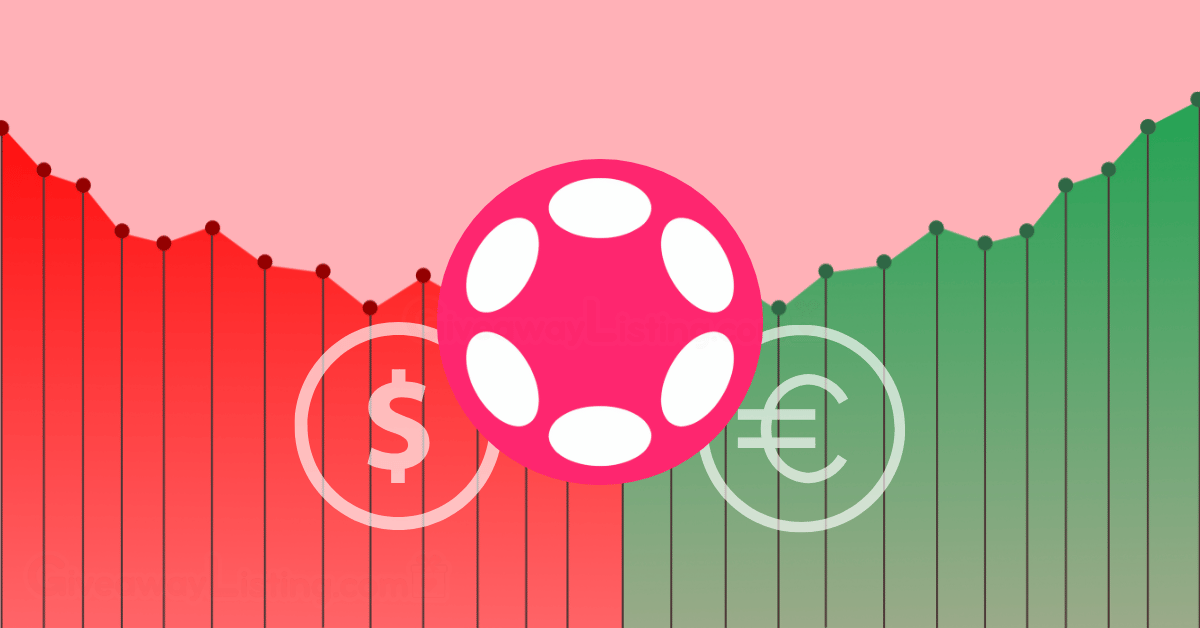DOT Price History Until Today
Polkadot is a blockchain platform designed to connect different, specialized blockchains into a single, unified network. Created by one of Ethereum’s original co-founders, its primary goal is to address the longstanding issue of blockchains being unable to communicate with each other. This enables the transfer of any data or asset, not just tokens, across different chains.
The platform operates on a multi-chain architecture, featuring a central Relay Chain that coordinates the system and numerous user-created parachains. This structure enables parallel transaction processing, significantly enhancing speed and scalability. The native token, DOT, is central to the network’s operation, serving as a means of governance, staking to secure the network, and bonding to add new parachains.
The price journey of Polkadot’s native token, DOT, has been a story of explosive growth followed by a prolonged market correction. After its launch in mid-2020, DOT quickly gained attention, but its most dramatic price action occurred during the 2021 bull market.
Following this peak, DOT’s value retreated significantly. The token’s price fell sharply and has since been trading in a much lower range. Despite the price decline, development on the Polkadot network has continued, with a growing number of projects building on its ecosystem.
This has created a dynamic where the network’s on-chain activity sometimes shows strength even when the token price is stagnant.
$DOT Price Historical Data From 2020 to 2025
The price of DOT has seen considerable shifts since its introduction. The token’s initial trading days set the stage for a volatile future, with its value experiencing major peaks and valleys in the years that followed.
| Year | Highest Price (USD) | Lowest Price (USD) |
|---|---|---|
| 2020 | $6.86 | $2.69 |
| 2021 | $55.00 | $4.59 |
| 2022 | $23.21 | $4.22 |
| 2023 | $7.90 | $3.57 |
| 2024 | $11.53 | $3.95 |
| 2025 | $8.18 | $3.27 |
Latest Polkadot Price Prediction for November 2025

The price of DOT has been in a consolidation phase for a while, trading significantly below its 2021 peak. After a brief rally at the start of 2024, the token has been moving within a relatively tight range. This period has been marked by low volatility compared to its past performance.
While the price has remained subdued, on-chain metrics like active addresses and transaction counts have shown periods of growth, indicating continued user engagement with the Polkadot ecosystem.
Several factors determine the value of DOT. Some of the most significant of them include:
- Broader Market Sentiment: The price of DOT is heavily influenced by the performance of major cryptocurrencies like Bitcoin and Ethereum. A bull or bear market for these leading assets typically sets the tone for the entire crypto space, including Polkadot.
- Ecosystem Growth and Adoption: The success of projects building on Polkadot, particularly its parachains, is critical. Increased adoption of applications in areas like DeFi and gaming on the network can drive demand for DOT.
- Technological Developments: Major network upgrades, such as the upcoming Polkadot 2.0, can impact investor confidence. These changes aim to make the network more flexible and efficient, which could be a positive price catalyst.
- Tokenomics and Staking: DOT’s inflation rate, staking rewards, and demand for bonding parachains all play a role in its supply and demand dynamics. High staking rates, for example, can reduce the circulating supply, potentially putting upward pressure on the price.
- Competition: Polkadot operates in a competitive environment with other platforms like Cosmos, Avalanche, and various Ethereum scaling solutions. Its ability to attract and retain developers and users in this landscape is crucial for its long-term value.
Analysts’ forecasts for Polkadot’s price in November 2025 are generally cautious, reflecting the token’s recent performance and the broader market’s uncertainty. Most predictions see DOT continuing its consolidation, with a price hovering in a narrow range. There isn’t a strong consensus for a major breakout in either direction during this period.
The sentiment suggests that while the downside may be limited due to the token having already undergone a significant correction, the short-term upside potential is also capped. The market appears to be in a “wait-and-see” mode, awaiting more definitive signs of growth in the Polkadot ecosystem or a strong bullish signal from the broader crypto market before committing to a significant price move.
Some analyses point to technical indicators suggesting a bearish or neutral outlook for the immediate future. The price is trading below key moving averages, and momentum indicators have not shown sustained strength.
However, other forecasts are slightly more optimistic, suggesting that a floor has been established and that any positive news could lead to a modest price increase.
Best 5 DOT Price Predictions in 2025

Predicting the price of any cryptocurrency is a tricky business, and Polkadot’s DOT is no exception. The general sentiment for 2025 is a mix of cautious optimism and consolidation. Many analysts see the current lower price points as a potential accumulation phase for long-term believers, especially with significant network upgrades on the horizon. The success of these updates, combined with broader market trends, will be a major factor in determining if DOT can begin to climb back toward its previous highs.
The rollout of Polkadot 2.0, which changes how the network allocates blockspace, is a key point of focus. This new model is designed to lower the barrier to entry for developers and could spark a new wave of projects within the ecosystem. If this leads to increased demand and on-chain activity, the value of DOT could see a positive reaction. However, the price will also be heavily influenced by the performance of Bitcoin and the overall macroeconomic environment.
Here are five notable price predictions for Polkadot (DOT) in 2025:
1. Changelly
The analysis from Changelly points to a year of moderate movement for DOT. Their forecast for 2025 suggests a minimum price of around $3.95 and a maximum price reaching up to $4.35. The average trading price is expected to hover around $4.15.
This prediction is based on technical analysis of historical price movements and suggests that while significant upward momentum isn’t guaranteed, the token is expected to maintain a stable, albeit tight, trading range throughout the year.
2. DigitalCoinPrice
The outlook from DigitalCoinPrice is considerably more bullish. Their model forecasts a minimum price of $3.46, but sees a potential high of $8.46 in 2025. The average price for the year is predicted to be around $7.94.
This more optimistic forecast is from the successful implementation of network upgrades and a more favorable overall crypto market, suggesting that new features could attract substantial investment and user activity, pushing the price well beyond its current levels.
3. Binance
Binance provides a more conservative forecast, projecting that the price of DOT will average $7.07 by the end of 2025. Their prediction model suggests that the price will remain relatively stable, reflecting steady but not explosive growth. This outlook likely considers the competitive landscape and the time it takes for network effects from upgrades to materialize into tangible price appreciation.
4. CoinDCX
The analysis provided by CoinDCX suggests a price range for DOT in 2025 between $12.5 and $15. This bullish prediction is based on the idea that Polkadot’s focus on interoperability will become increasingly important as the Web3 space matures.
They believe that as more blockchains are created, the need for a network that can connect them all will drive significant value to the DOT token, justifying a higher valuation.
5. Kraken
Kraken’s analysis frequently emphasizes the fundamental strengths of the Polkadot network. The platform highlights the potential impact of the parachain ecosystem and the growing number of developers building on Polkadot. The general sentiment is that if the ecosystem continues to expand and attract high-quality projects, the inherent demand for DOT for staking, governance, and bonding could support a positive price trend in 2025.
Is Polkadot a Good Investment?

Polkadot represents an investment in the idea of a multi-chain future. Instead of betting on a single blockchain to rule them all, an investment in DOT is a bet that many different blockchains will coexist and need to communicate with one another. Polkadot was designed to serve as the underlying infrastructure that connects these disparate networks, enabling them to securely share data and assets. This makes it a foundational play in the Web3 space.
However, an investment in Polkadot is not without its considerations. The project faces stiff competition from other interoperability-focused platforms, such as Cosmos (ATOM) and Avalanche (AVAX), as well as from Layer-2 scaling solutions on Ethereum.
Historically, DOT’s price has not always moved in lockstep with its technological progress, which has led many to describe it as having weak price action. The token’s supply is also inflationary, designed to reward stakers who secure the network, which can put downward pressure on the price if demand does not keep pace.
Potential Advantages of Investing in Polkadot
- Interoperability: It solves a major problem by allowing different blockchains to communicate, which could be critical for the future of Web3.
- Scalability: The multi-chain design enables parallel transaction processing, allowing for higher throughput than many single-chain networks. Polkadot’s network has been tested to support a maximum of 623,000 transactions per second, a figure that significantly outperforms many of its competitors.
- Strong Developer Base: It has consistently ranked as one of the top blockchain ecosystems for active developer talent, after Ethereum, Base, and Polygon. This is a strong indicator of a healthy and growing platform.
- On-Chain Governance: DOT holders have direct control over the network’s future, with the ability to vote on everything from network fees to code upgrades.
- Staking Rewards: Investors can stake their DOT tokens to help secure the network and earn passive rewards, which currently yield an average annual return.
Potential Risks of Investing in Polkadot
- Intense Competition: Polkadot is not the only project working on interoperability. It competes with established and emerging players, and its market share is not guaranteed.
- Market Volatility: Like all cryptocurrencies, DOT is subject to extreme price volatility. Its value can change dramatically in a short period.
- Complexity: The technology behind Polkadot is advanced and can be challenging for newcomers to comprehend fully, which may hinder mainstream adoption.
- Token Unlocks: The periodic release of new tokens into the circulating supply can create selling pressure if demand doesn’t grow to absorb them.
Polkadot is a suitable investment option for individuals with a long-term perspective who believe in the vision of an interconnected, multi-chain web. It’s not a project for those seeking quick, short-term profits. The value proposition of DOT is tied to the growth and adoption of its entire ecosystem. If you believe that its parachains will attract more users and applications over time, then the current price levels could be an attractive entry point.
Investing in Polkadot requires patience and a good understanding of the technology. Here is how you can get started:
- Select a reputable cryptocurrency exchange that lists Polkadot (DOT).
- Create and verify your account on the chosen platform.
- Deposit funds into your account using a bank transfer, credit/debit card, or another cryptocurrency.
- Navigate to the trading section and find the DOT trading pair, e.g., DOT/USD.
- Enter the amount of DOT you wish to purchase and place your order.
- Once the order is filled, transfer your DOT to a secure personal wallet for long-term storage.
How to Sell $DOT?
Selling your DOT follows a process almost identical to the purchase process. First, you’ll need to send your DOT from your private wallet back to your account on a cryptocurrency exchange. Be sure to send it to the correct Polkadot deposit address provided by the exchange.
Once the transaction is confirmed on the blockchain and the funds appear in your exchange wallet, you can place a sell order. You can choose to sell it for fiat currency, which you can then withdraw to your bank account, or trade it for another cryptocurrency, such as Bitcoin, Ethereum, or a stablecoin like USDT.
Polkadot Forecast After 2025

The journey of Polkadot’s token, $DOT, has been a rollercoaster. During the 2021 bull run, $DOT reached an impressive all-time high of nearly $55, fueled by excitement over its innovative multi-chain architecture. However, the subsequent market correction brought it back to earth, with the token price spending long periods in the single digits, sometimes struggling to hold the $5 line. This has led some to view it as an underperformer compared to giants like Bitcoin and Ethereum, especially given the project’s strong technological foundation and active developer community.
Going through the price history, the current valuation represents a fraction of its peak. Over the past few years, $DOT has seen its market capitalization shrink from over $50 billion to a current range of $6-$7 billion. Despite this, on-chain activity has shown signs of life, with monthly transactions growing significantly.
The table below shows a forecast of the DOT prices from 2026 to 2030:
| Year | Low Estimate | Average Price | High Estimate |
|---|---|---|---|
| 2026 | $4.04 | $6.64 | $9.84 |
| 2027 | $9.96 | $10.25 | $13.92 |
| 2028 | $14.52 | $15.03 | $17.60 |
| 2029 | $17.00 | $21.63 | $25.49 |
| 2030 | $20.44 | $30.52 | $36.47 |
Trading Strategies For Polkadot

Trading a token as dynamic as $DOT requires more than just following the hype. A well-thought-out plan is crucial for managing the risks associated with its price fluctuations and making informed decisions.
Simply buying during a green market or selling in a panic can create a loss. Instead, a strategic approach involves examining the project’s long-term value, understanding the technical aspects of its price chart, and being aware of specific events, such as token unlocks, that can impact supply.
Combining different methods can provide a more balanced approach to the market, whether you’re looking for long-term holds or shorter-term trades.
Long-Term Holding Based on Fundamentals
This strategy is designed for individuals who share the core mission of Polkadot. It’s less about short-term price charts and more about the project’s long-term potential to solve real problems in the blockchain space.
This isn’t a “get rich quick” method. It requires patience and a strong conviction in the project’s vision. You’ll need to stay informed about development progress, ecosystem growth, and how Polkadot stacks up against competitors like Cosmos and Avalanche.
The idea is to accumulate during market downturns and hold through the volatility, banking on the thesis that a truly interoperable web will be massively valuable in the future.
Watch the Tokenomics and Unlock Schedules
A smart trader pays close attention to a token’s supply dynamics. For Polkadot, this includes being aware of its inflation model and, more importantly, its token unlock schedule. When large amounts of previously locked tokens are released into the circulating supply, it can create significant selling pressure. This happens when tokens from early investors, team allocations, or even staked DOT from expired parachain leases become liquid.
If the market’s demand isn’t strong enough to absorb this new supply, the price can dip. You can often find information about these schedules through project documentation or crypto data platforms. Being aware of a major upcoming unlock can help you time your entry or exit points more effectively. For instance, you might decide to wait until after a large unlock to buy, anticipating a potential price drop.
Staking for Passive Rewards
Staking is a core function of the Polkadot network, offering a way to generate returns on your $DOT holdings while contributing to network security. Polkadot uses a Nominated Proof-of-Stake (NPoS) system. As a token holder, you can act as a “nominator” by selecting and “nominating” trustworthy validators who are responsible for confirming transactions and producing blocks.
When these validators earn rewards for their work, a portion of those rewards is passed on to you. This provides a steady stream of passive income in the form of more $DOT tokens. This strategy is particularly useful for long-term holders, as the staking rewards can help compound your position over time and offset some of the effects of price volatility. Even if the market is trading sideways, you’re still increasing your total number of tokens.
There are several ways to stake, ranging from using a non-custodial wallet for maximum control to participating through a cryptocurrency exchange for greater convenience. With the introduction of nomination pools, users can start staking with as little as 1 DOT, making it accessible to almost everyone. However, it’s essential to do your research when selecting validators. If a validator you nominate acts maliciously or has significant downtime, they can be “slashed,” meaning both they and their nominators lose a portion of their staked DOT.
How to Learn More About Polkadot?

Polkadot’s multi-chain architecture, featuring a central Relay Chain and numerous parallel “parachains,” introduces a level of technical depth not seen in many other blockchain projects. For newcomers, understanding concepts like shared security, cross-chain messaging (XCM), and the token’s triple role in governance, staking, and bonding can be a steep learning curve.
Getting a firm grasp of these fundamentals is key before trying to make sense of its market movements and investment potential. For those seeking a better understanding of the ecosystem, several resources provide valuable information tailored to various levels of expertise.
- Polkadot Wiki: This is the project’s official and most exhaustive knowledge base. It’s the go-to resource for anyone seeking a granular understanding of the technology, from the NPoS (Nominated Proof-of-Stake) consensus mechanism to the specifics of parachain auctions. While dense, it is the primary source of truth for the technical details that underpin the network’s value.
- Polkadot Forum: This is the heart of the community and governance activity. By reading through discussions, you can gain insight into proposals for the network’s future, understand community sentiment, and identify the features or problems thatare top of mind for active members. It’s an excellent way to get insight into the human element driving the protocol.
- Social Channels like Reddit and X/Twitter: The
r/Polkadotsubreddit and X accounts such as@learnpolkadotoffer real-time conversations and news. These platforms are useful for immediate updates, asking questions, and engaging with a broad community of enthusiasts and experts. To stay informed about fast-paced developments that can impact prices, it’s a good idea to follow the latest Polkadot news.
This guide provided an overview of Polkadot, a blockchain platform created by Ethereum co-founder Gavin Wood to solve the problem of interoperability. We examined its unique structure, which utilizes a Relay Chain to connect multiple specialized blockchains, known as parachains. This design enables scalability, allowing different networks to communicate and share security.
The information provided in this content is up to date as of November 2025.
Polkadot Price Prediction FAQs
Here are answers to some frequently asked questions about Polkadot price prediction in 2025:
How Much Will Polkadot Be Worth in 2025?
Forecasts for Polkadot’s 2025 price show a wide range of possibilities. Some analyses suggest an average price range of $3.50 to $8.50, reflecting steady ecosystem growth.
Is Polkadot a Good Investment?
Polkadot is often considered a long-term project due to its focus on foundational web infrastructure. The network supports over 600 projects and is backed by a strong development team. However, its token is subject to high market volatility and faces competition from other blockchain platforms.
Can Polkadot Reach $100?
For DOT to reach $100, it would need to significantly surpass its previous all-time high of approximately $55. This would require a major bull market and widespread adoption of its technology. While some long-range forecasts predict this is possible after 2030, it remains a very ambitious target.
Does Polkadot Have a Future?
Polkadot’s future appears solid, anchored by ongoing technical updates like the JAM Gray Paper and Agile Coretime. The ecosystem is supported by a large community, including over 1.3 million DAO members, and is led by one of Ethereum’s original co-founders. Its goal of creating an interoperable web addresses a key issue in the blockchain space.

